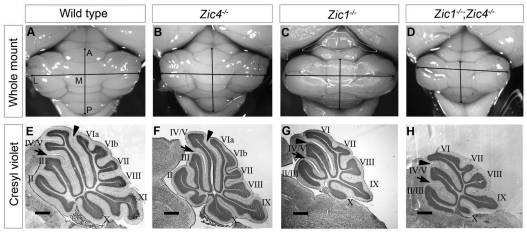Fig. 1.
Zic1 and Zic4 mutants have cerebellar size and foliation defects. (A-D) Dorsal views of whole P20 cerebella show that Zic4−/− (B) cerebella were slightly smaller than wild type (A). Zic1−/− (C) and Zic1−/−;Zic4−/− (D) cerebella were much smaller than wild type along the anterior-posterior (AP) axis and Zic1−/−;Zic4−/− cerebella were also smaller along the medial-lateral (ML) axis. (E-H) Cresyl Violet-stained sagittal sections through the cerebellar vermis. Black arrowheads and arrows indicate the primary and preculminate fissures, respectively, and folia are labeled with roman numerals (II-X). Wild-type (E) and Zic4−/− (F) cerebella had three folia anterior to the primary fissure, whereas Zic1−/− (G) and Zic1−/−;Zic4−/− (H) cerebella were dramatically hypoplastic, were missing one anterior folium and lacked a fissure between folia VIa and VIb. Scale bars: 500 μm in E-H.

